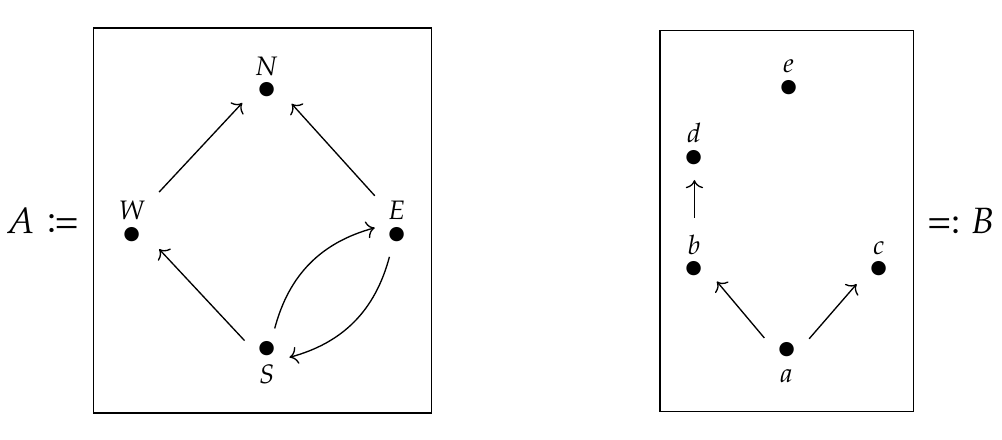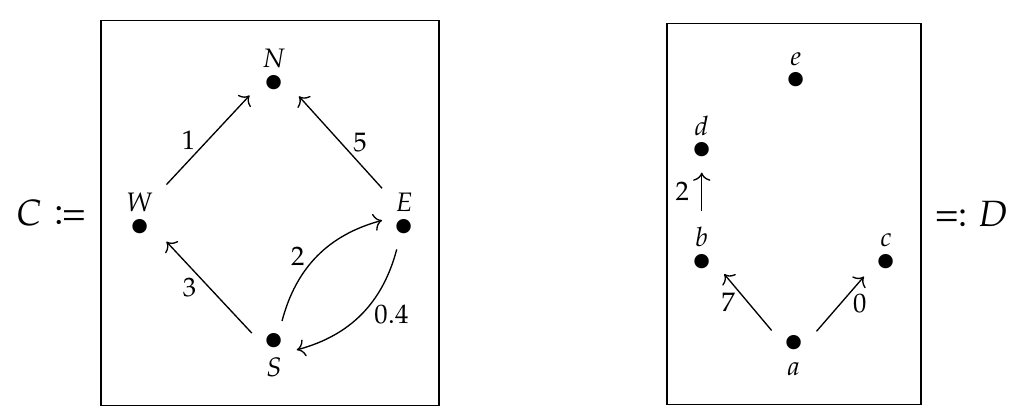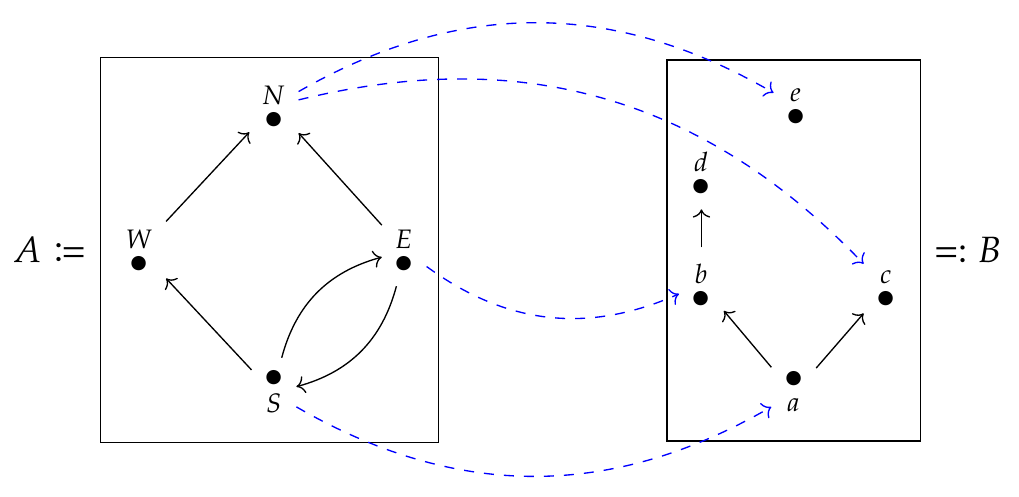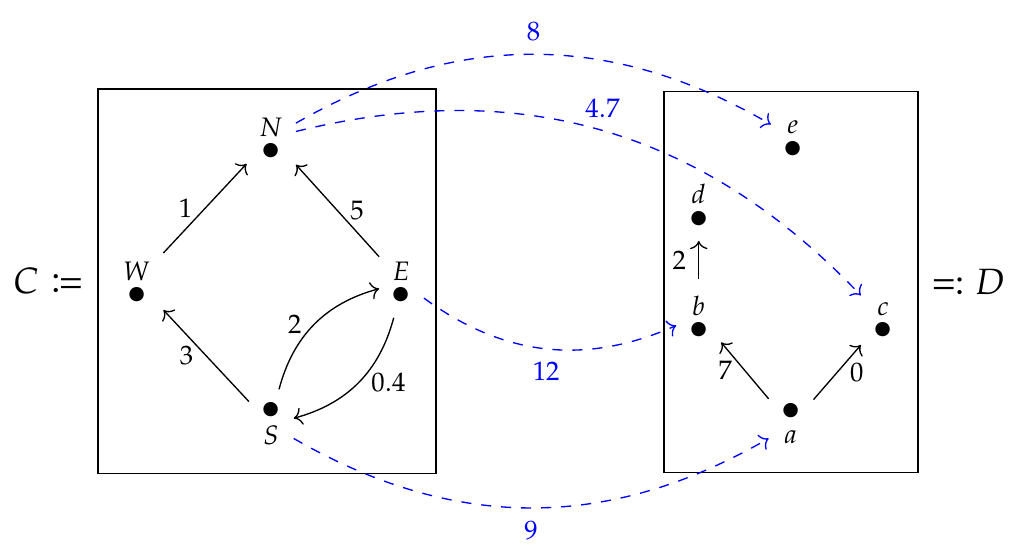We've been looking at feasibility relations, as our first example of enriched profunctors. Now let's look at another example. This combines many ideas we've discussed - but don't worry, I'll review them, and if you forget some definitions just click on the links to earlier lectures!
Remember, \\(\mathbf{Bool} = \lbrace \text{true}, \text{false} \rbrace \\) is the [preorder](https://forum.azimuthproject.org/discussion/1812/lecture-3-chapter-1-posets/p1) that we use to answer true-or-false questions like
* _can we_ get from here to there?
while \\(\mathbf{Cost} = [0,\infty] \\) is the preorder that we use to answer quantitative questions like
* _how much does it cost_ to get from here to there?
or
* _how far is it_ from here to there?
In \\(\textbf{Cost}\\) we use \\(\infty\\) to mean it's impossible to get from here to there: it plays the same role that \\(\text{false}\\) does in \\(\textbf{Bool}\\). And remember, the ordering in \\(\textbf{Cost}\\) is the _opposite_ of the usual order of numbers! This is good, because it means we have
\[ \infty \le x \text{ for all } x \in \mathbf{Cost} \]
just as we have
\[ \text{false} \le x \text{ for all } x \in \mathbf{Bool} .\]
Now, \\(\mathbf{Bool}\\) and \\(\mathbf{Cost}\\) are [monoidal preorders](https://forum.azimuthproject.org/discussion/2082/lecture-21-chapter-2-monoidal-preorders/p1), which are just what we've been using to define [enriched categories](https://forum.azimuthproject.org/discussion/2121/lecture-29-chapter-2-enriched-categories/p1)! This let us define
* [\\(\mathbf{Bool}\\)-enriched categories](https://forum.azimuthproject.org/discussion/2124/lecture-30-chapter-1-preorders-as-enriched-categories/p1), which are just **preorders**
and
* [\\(\mathbf{Cost}\\)-enriched categories](https://forum.azimuthproject.org/discussion/2128/lecture-31-chapter-2-lawvere-metric-spaces/p1), which are **Lawvere metric spaces**.
We can draw preorders using graphs, like these:
 An edge from \\(x\\) to \\(y\\) means \\(x \le y\\), and we can derive other inequalities from these. Similarly, we can draw Lawvere metric spaces using \\(\mathbf{Cost}\\)-weighted graphs, like these:
An edge from \\(x\\) to \\(y\\) means \\(x \le y\\), and we can derive other inequalities from these. Similarly, we can draw Lawvere metric spaces using \\(\mathbf{Cost}\\)-weighted graphs, like these:
 The distance from \\(x\\) to \\(y\\) is the length of the shortest directed path from \\(x\\) to \\(y\\), or \\(\infty\\) if no path exists.
All this is old stuff; now we're thinking about [enriched profunctors](https://forum.azimuthproject.org/discussion/2278/lecture-55-chapter-4-enriched-profunctors/p1) between enriched categories.
A \\(\mathbf{Bool}\\)-enriched profunctor between \\(\mathbf{Bool}\\)-enriched categories also called a [feasibility relation](https://forum.azimuthproject.org/discussion/2281/lecture-57-chapter-4-feasibility-relations/p1) between preorders, and we can draw one like this:
The distance from \\(x\\) to \\(y\\) is the length of the shortest directed path from \\(x\\) to \\(y\\), or \\(\infty\\) if no path exists.
All this is old stuff; now we're thinking about [enriched profunctors](https://forum.azimuthproject.org/discussion/2278/lecture-55-chapter-4-enriched-profunctors/p1) between enriched categories.
A \\(\mathbf{Bool}\\)-enriched profunctor between \\(\mathbf{Bool}\\)-enriched categories also called a [feasibility relation](https://forum.azimuthproject.org/discussion/2281/lecture-57-chapter-4-feasibility-relations/p1) between preorders, and we can draw one like this:
 What's a \\(\mathbf{Cost}\\)-enriched profunctor between \\(\mathbf{Cost}\\)-enriched categories? It should be no surprise that we can draw one like this:
What's a \\(\mathbf{Cost}\\)-enriched profunctor between \\(\mathbf{Cost}\\)-enriched categories? It should be no surprise that we can draw one like this:
 You can think of \\(C\\) and \\(D\\) as countries with toll roads between the different cities; then an enriched profunctor \\(\Phi : C \nrightarrow D\\) gives us the cost of getting from any city \\(c \in C\\) to any city \\(d \in D\\). This cost is \\(\Phi(c,d) \in \mathbf{Cost}\\).
But to specify \\(\Phi\\), it's enough to specify costs of flights from _some_ cities in \\(C\\) to _some_ cities in \\(D\\). That's why we just need to draw a _few_ blue dashed edges labelled with costs. We can use this to work out the cost of going from any city \\(c \in C\\) to any city \\(d \in D\\). I hope you can guess how!
**Puzzle 182.** What's \\(\Phi(E,a)\\)?
**Puzzle 183.** What's \\(\Phi(W,c)\\)?
**Puzzle 184.** What's \\(\Phi(E,c)\\)?
**Puzzle 185.** In general, a \\(\mathbf{Cost}\\)-enriched profunctor \\(\Phi : C \nrightarrow D\\) is defined to be a [\\(\mathbf{Cost}\\)-enriched functor](https://forum.azimuthproject.org/discussion/2169/lecture-32-chapter-2-enriched-functors/p1)
\[ \Phi : C^{\text{op}} \times D \to \mathbf{Cost} \]
This is a function that assigns to any \\(c \in C\\) and \\(d \in D\\) a cost \\(\Phi(c,d)\\). However, to be a \\(\mathbf{Cost}\\)-enriched functor it needs to obey some properties! What are these properties? What do they mean in terms of trips between cities?
**Puzzle 185.** Are the graphs we used above to describe the preorders \\(A\\) and \\(B\\) [Hasse diagrams](https://en.wikipedia.org/wiki/Hasse_diagram)? Why or why not?
**Puzzle 186.** I said that \\(\infty\\) plays the same role in \\(\textbf{Cost}\\) that \\(\text{false}\\) does in \\(\textbf{Bool}\\). What exactly is this role?
**Puzzle 187.** Choose some other monoidal preorder \\(\mathcal{V}\\) and draw, or otherwise describe, an example of a \\(\mathcal{V}\\)-enriched profunctor between \\(\mathcal{V}\\)-enriched categories.
By the way, people often say **\\(\mathcal{V}\\)-category** to mean \\(\mathcal{V}\\)-enriched category, and **\\(\mathcal{V}\\)-functor** to mean \\(\mathcal{V}\\)-enriched functor, and **\\(\mathcal{V}\\)-profunctor** to mean \\(\mathcal{V}\\)-enriched profunctor. This helps you talk faster and do more math per hour.
**[To read other lectures go here.](http://www.azimuthproject.org/azimuth/show/Applied+Category+Theory#Chapter_4)**
You can think of \\(C\\) and \\(D\\) as countries with toll roads between the different cities; then an enriched profunctor \\(\Phi : C \nrightarrow D\\) gives us the cost of getting from any city \\(c \in C\\) to any city \\(d \in D\\). This cost is \\(\Phi(c,d) \in \mathbf{Cost}\\).
But to specify \\(\Phi\\), it's enough to specify costs of flights from _some_ cities in \\(C\\) to _some_ cities in \\(D\\). That's why we just need to draw a _few_ blue dashed edges labelled with costs. We can use this to work out the cost of going from any city \\(c \in C\\) to any city \\(d \in D\\). I hope you can guess how!
**Puzzle 182.** What's \\(\Phi(E,a)\\)?
**Puzzle 183.** What's \\(\Phi(W,c)\\)?
**Puzzle 184.** What's \\(\Phi(E,c)\\)?
**Puzzle 185.** In general, a \\(\mathbf{Cost}\\)-enriched profunctor \\(\Phi : C \nrightarrow D\\) is defined to be a [\\(\mathbf{Cost}\\)-enriched functor](https://forum.azimuthproject.org/discussion/2169/lecture-32-chapter-2-enriched-functors/p1)
\[ \Phi : C^{\text{op}} \times D \to \mathbf{Cost} \]
This is a function that assigns to any \\(c \in C\\) and \\(d \in D\\) a cost \\(\Phi(c,d)\\). However, to be a \\(\mathbf{Cost}\\)-enriched functor it needs to obey some properties! What are these properties? What do they mean in terms of trips between cities?
**Puzzle 185.** Are the graphs we used above to describe the preorders \\(A\\) and \\(B\\) [Hasse diagrams](https://en.wikipedia.org/wiki/Hasse_diagram)? Why or why not?
**Puzzle 186.** I said that \\(\infty\\) plays the same role in \\(\textbf{Cost}\\) that \\(\text{false}\\) does in \\(\textbf{Bool}\\). What exactly is this role?
**Puzzle 187.** Choose some other monoidal preorder \\(\mathcal{V}\\) and draw, or otherwise describe, an example of a \\(\mathcal{V}\\)-enriched profunctor between \\(\mathcal{V}\\)-enriched categories.
By the way, people often say **\\(\mathcal{V}\\)-category** to mean \\(\mathcal{V}\\)-enriched category, and **\\(\mathcal{V}\\)-functor** to mean \\(\mathcal{V}\\)-enriched functor, and **\\(\mathcal{V}\\)-profunctor** to mean \\(\mathcal{V}\\)-enriched profunctor. This helps you talk faster and do more math per hour.
**[To read other lectures go here.](http://www.azimuthproject.org/azimuth/show/Applied+Category+Theory#Chapter_4)**




